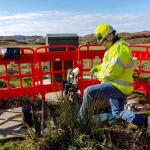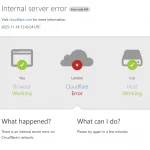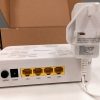BT Group Extend FTTP Broadband Cover to 15 Million UK Premises

Telecoms giant BT Group have today posted a brief trading update to the end of June 2024, which reveals that Openreach added another 1 million premises (unchanged on the previous quarter) to the coverage of their full fibre (FTTP) broadband ISP network – delivering total coverage to 15 million. Take-up also held at a steady 34%.
Take note that, since 2023, the BT Group now only publishes a short trading update in calendar Q1 and Q3 (roughly in line with most FTSE 100 companies), thus we only get a very limited summary this time around – the full details come in Q2 and Q4. As such, we’ve opted to do a similarly brief update on the key details below.
In terms of the headline changes. The latest results also revealed that Openreach’s full fibre rollout was now running at a build rate of 78,000 premises passed per week (unchanged) and related FTTP customers grew to total 5 million (up from 4.701m) across multiple ISPs, which gives them a take-up of 34%. We get a BT Consumer (retail) specific breakdown below.
Advertisement
In addition, it’s worth contrasting these results against BT’s current targets for 2030, which among other things have predicted that their total labour force would shrink to between 75,000 and 90,000 (e.g. many of the engineers they have today won’t be needed post-2030) and FTTP coverage would grow to between 25-30 million premises, while delivering take-up of around 40-55% by this same date.
BT also holds a target of 13.0-14.5 million retail 5G mobile connections via EE, although annoyingly the latest trading update doesn’t provide any data on 5G specific customers or network coverage.
BT’s CEO, Allison Kirkby, said:
“We’ve made a solid start to the year, with excellent growth in both fibre build and connections, and increased EBITDA.
Openreach continues to build at pace and with even more efficiency, passing the milestones of 5 million connections and – just yesterday – 15 million premises built. In Consumer, the widespread availability of FTTP and 5G combined with our new EE propositions has contributed to an improved trend in our customer base, in what remains a very competitive market. In Business, we also saw improved trends, as we continue to modernise our portfolio and our operations towards a simpler business, delivering secure, cloud-based connectivity and communication services for all our customers.
Our ongoing cost transformation contributed to EBITDA growth, and more than offset the expected revenue declines in Consumer and Business in the quarter. There is much more to do to simplify BT Group and deliver for our customers. We remain on track to deliver our financial outlook for this year and our cash flow inflection to c. £2.0bn in 2027 and c. £3.0bn by the end of the decade.”
BT Group’s June 2024 Performance Summary
• Record FTTP build of over 1m premises passed in the quarter at an average build rate of 78k per week; FTTP footprint is now 15m with 4.2m rural premises passed and around a further 6m where initial build is underway
• FTTP customer base surpassed 5m during the quarter; strong FTTP demand with orders up 29% year-on-year; take up rate is at 34% with continued strong net adds of 387k
• Openreach broadband ARPU grew by 6% year-on-year due to price rises and increased volumes of FTTP; Openreach broadband line losses of 196k, with moderately higher competitor losses combined with a weaker overall broadband and new homes market
• Consumer broadband ARPU up 1% year-on-year to £42.4 and Consumer postpaid mobile ARPU increased 0.5% year-on-year to £19.8, with positive mix effects offsetting the expected tougher pricing comparative
• Consumer base trend improved despite a competitive market, with the broadband base down 28k quarter-on-quarter (0.3% decline) and postpaid mobile base down 15k quarter-on-quarter (0.1% decline)
• Business financial performance continues to be impacted by legacy managed contract declines, reduced low margin sales activity and contraction in the portfolio unit offset by cost transformation
• Retail FTTP base grew year-on-year by 36% to 2.7m of which Consumer 2.6m and Business 0.1m; 5G base 11.3m, up 22% year-on-year
• BT Group NPS of 25.1, up 0.3pts year-on-year, demonstrating further improving customer experience
• BT Group has been recognised by TIME Magazine and Statista as one of the “World’s Most Sustainable Companies 2024”
One thing worth noting above is that, despite the rapid growth of their FTTP network coverage, Openreach still suffered a loss of 196,000 broadband lines (across all technologies) as competing networks continued to eat into their overall market share.
Mark is a professional technology writer, IT consultant and computer engineer from Dorset (England), he also founded ISPreview in 1999 and enjoys analysing the latest telecoms and broadband developments. Find me on X (Twitter), Mastodon, Facebook, BlueSky, Threads.net and Linkedin.
« KCOM Expands FTTP Broadband Network into 2 New Villages






















































“BT Group Extend legacy GPON FTTP Broadband Cover to 15 Million UK Premises”
“BT Group extend cost effective GPON FTTP broadband cover to 15 million UK premises, with market leading footprint and takeup, no concerns about financial viability, and an easy upgrade path when the market determines it is necessary”
No Ivor, “BT deploys wrong technology yet again, meaning Brits will wait years for an upgrade to better technology as rivals deploy the correct technology”
“Easy Upgrade” – with BT? Pah! Always takes years and years and years and years, after trials and trials and trials…..
Yep. GPON and asymmetric will be around for the next 20 years while they milk it for all it’s worth.
The economics already say XGS-PON is the better approach for new installs.
XGS-PON on a 1:64 split now comes in at a significantly lower cost than GPON on 1:32 for the OLTs. Those OLTs use less power per end user and take less space. The ONTs are now getting to be comparable on cost as apart from Openreach the main buyers and development is on XGS-PON worldwide.
So why keep installing GPON? all that does is install an older technology at a higher cost and shorter life. With 1:64 split you have twice the bandwidth of GPON for each customer and build it right you can move back to 1:32 later simply. Openreach are going to have a massive problem they already have 5M+ GPON ONTs out there and in excess of 300,000 GPON ports that will need to be upgraded. Last I heard from Openreach was they were sticking GPON until it made sense to move to 1:32 split on XGS.
Is there anyone else in the UK still installing GPON? VMO2/Nexfibre are XGS-PON, as are the likes of Hyperoptic and CityFibre.
xgs-pon is legacy vs 50g pon. and the fibre network is the same anyway
What technology do Virgin Media use?
VM use XGS-PON for NexFibre network and their HFC and RFoG is going XGS-PON by 2028.
50G PON isn’t yet credible enough as hardly deployed. XGS-PON is the technology that BT should have done, even Cityfibre are managing to convert GPON to XGS-PON for those parts of its network that started off GPON. BT in slow lane again.
They finally did my house. It only took 43 years of my life to get fibre, but better late than never right?
What use case did you have for fibre to the home in 1981?
It helps with take up when you have a legacy copper customer base to organically migrate. I’m thinking the 40-55% predicted take up is probably quite conservative (probably to avoid incurring the wrath of Ofcom). Openreach FTTP has been live in our street just shy of 3 years and has a take up rate of 54% even though there is an altnet which has been live since January. More generally looking round the area they still seem to still be getting the lions share of new connections (you can tell the new installs as they have gone over to a new CSP splicing box which is considerably smaller than the old one).
I would assume that a large number of people think that they already have “fibre” when in fact they have VDSL copper. I recall trying to get a community to apply for vouchers to get fibre and the vast number of people who we spoke to said they didn’t understand because they thought they already had fibre. But we’re also talking about people who call their internet “WiFi”.
I hope they hurry up with the rest of the Plymouth rollout, they been working on it since November and it’s still not available to order.
Using virgin at the moment and I can’t wait to get out of this rubbish, it’s declined so much in recent years with actual downtimes it’s poor latency on the network but bandwidth is actually ok.
Cityfibre don’t even have a plan for my area anymore it was in “phase 2” but that seems to have dropped off the earth so the only option is literally virgin (1gb) or BT 40mb/s!
Feel very impatient but virgin media irritate me too much and are too expensive.
Not sure if you mean they started in November but a city of a quarter of a million people it’s unlikely to finish rollout in 8 months
No sorry I don’t mean the entire of Plymouth, a lot of it has had open reach FTTP for years! It’s a specific exchange basically over the bridge they haven’t done anything and finally started 2 years later than they said they would.
In their “plans” it’s services should be available within 12 months and that was from over a year ago really but I guess their still behind and the way they do the listing is a bit poor for timelines.
If they don’t fix all the problems in EE (BT) broadband, they’ll be more leaving…